
Diary: The garden in October 2000

 | Diary: The garden in October 2000 |

|
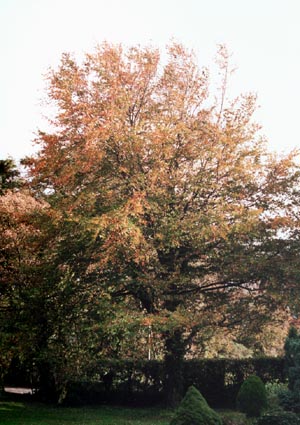
On the 3rd there was another gale, stronger than the last on 27th September. It was blowing well from first light and beechnuts were being thrown like missiles on to the windows making quite a clatter. It was a day to stay indoors! During the afternoon with the wind gusting to 60 mph the electricity supply failed but was restored within an hour. During the night several pots of plants were blown over around the house and the runner bean and sweet pea supports partially blown over. No other damage was done even the chrysanthemums, still outside the greenhouse, suffered no damage. They had been well tied in to their supporting canes; the canes are also tied together at their tops and to the greenhouse! Usually we have them safely in the greenhouse by now but this year not so. With this early taste of the winter gales to come it is time the job was done and the garden tidied up for the winter. Leaves from the sycamore and ash trees are covering the grassed areas under the trees and around the house in soggy heaps and need to be cleared. But there have not been many fine days, so far this autumn, when this work could have been done.
With all the summer visiting birds gone from the garden it is the residents that have it to themselves, at least until the winter visitors arrive. We have started doing counts of birds feeding on food we have put out for them. At the moment we are providing peanuts, in a feeder hung from the branch of a tree, together with mixed table seed, and bread scraps, on a bird table near the kitchen window and a ground table near the greenhouse. The counts are for the British Trust for Ornithology's Garden Bird Feeding Survey. We are one of about 250 gardens over the UK that does this survey that runs from October to the end of March each year. We also record birds seen in the garden for the Garden BirdWatch Survey that carries on throughout the year. It is a question of additionally recording the numbers of those birds we observe feeding. Some numbers are similar but there are birds that hardly ever take food but most have water, which counts. For the week beginning the 8th we have seen feeding 2 blue tits, 2 robins, 6 chaffinches, 1 great tit, 6 greenfinches, 1 collared dove, 1 great spotted woodpecker, 1 magpie, 1 nuthatch and 1 wren that went for water. Additional birds that we saw in and around the garden included a male blackbird, a raven, a buzzard and a few rooks. We also heard a tawny owl. Our tally for the week was 18 species, 12 that were feeding. This may not seem a very large number but it is the maximum number of any species seen at one time during the week. There are lots of birds around but, for the purposes of the survey, they must be seen together. The numbers are recorded on special recording sheets, which are sent in the BTO every 3 months. There the results for all the gardens are processed and the data used for research. Some of the results are published in the quarterly bulletin The Bird Table that is sent out to participants. It is very interesting to see how our garden compares with the average of all gardens. Once a month our observations are collated and put on to our GBW page. You can see how your garden compares with ours. Why not consider taking part yourself?
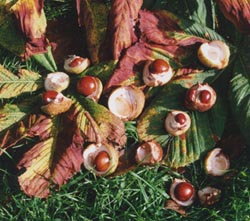
The first ground frost of the autumn was on the 11th; it was only slight and appeared not to have much effect on plants that are still flowering. The trees particularly the beeches and horse chestnut now have their fine autumn colours. When we get some sunshine the leaves really glow with colours from yellow to rusty brown. The conkers on the horse chestnut are now ripe and have been falling to the ground and splitting open to reveal the shiny seed. There is something appealing about fresh shiny conkers; local boys, who know we have horse chestnut trees, to collect them, have visited us. Of course the squirrels have been after them as well, but with a good crop this year they have not been in short supply, plenty for everyone. The squirrels will eat some but the majority they will take away and hide away or bury in the ground as a winter store. They never have needed all they bury, or cannot find them again because lots of them germinate next year in the most unlikely places. The vegetable plot is a favourite place! We hear that the red squirrels in the pine forest at Mynydd Llwydiarch near Pentraeth are still doing well. This is one of a rather few number of remaining populations. Blame on their scarcity has been put on the introduction of the grey, competition for food and, or disease. 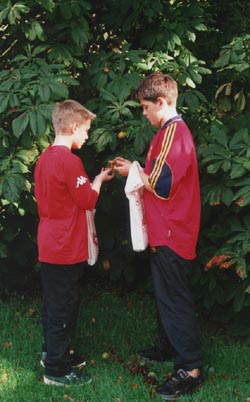 We used to have 1 or 2 red squirrels here, some years ago now. It is not far from the forest Pentraeth; it would be quite possible for them to make their way along the hedgerows or across the few fields to our wood. We keep hoping to see them again. The Welsh poppies are continuing to produce the odd flower per plant. As there are several dozen plants over the garden they show up as bright spots on these rather dull days. The Brittany sage is still flowering well as are the lavenders. The Clematis Ville de Lyon is still flowering on the fence bordering the lavender bed. The heather borders are continuing to flower in every month of the year. As well as the Cornish Heath we have St. Daboec's Heath or Irish Bell Heather. This occurs in Spain but more abundantly on the damper moors of Co. Mayo and Galway in Ireland. They grow best in bogs but grow here as well and are particularly suitable in semi-shaded spots in the shadow of our trees and house. We have Daboecia alba an outstanding white and D. atropurpurea with rich purple colours. Both are about 2ft tall and flower from June to October or November. On the terrace some of the fuchsias have flowers, as does the every-flowering pelargonium. These pots have now been moved to the shelter of the house; the pelargonium is in its corner to the right of the picture. Also here are the agapanthus. The northeast of the house is the driest and is the best place to over-winter the plants. Here the main problem is wetness; some plants just rot away. If they can be kept relatively dry they survive. Cold is not usually a problem here as we have mild winters; if cold weather occurs we cover the pots with fleece. Some plants we do put into the greenhouse; we make sure that at least one plant of the pelargonium is inside. Other plants that we house include the potted lemon tree and mesembryanthemums.
We used to have 1 or 2 red squirrels here, some years ago now. It is not far from the forest Pentraeth; it would be quite possible for them to make their way along the hedgerows or across the few fields to our wood. We keep hoping to see them again. The Welsh poppies are continuing to produce the odd flower per plant. As there are several dozen plants over the garden they show up as bright spots on these rather dull days. The Brittany sage is still flowering well as are the lavenders. The Clematis Ville de Lyon is still flowering on the fence bordering the lavender bed. The heather borders are continuing to flower in every month of the year. As well as the Cornish Heath we have St. Daboec's Heath or Irish Bell Heather. This occurs in Spain but more abundantly on the damper moors of Co. Mayo and Galway in Ireland. They grow best in bogs but grow here as well and are particularly suitable in semi-shaded spots in the shadow of our trees and house. We have Daboecia alba an outstanding white and D. atropurpurea with rich purple colours. Both are about 2ft tall and flower from June to October or November. On the terrace some of the fuchsias have flowers, as does the every-flowering pelargonium. These pots have now been moved to the shelter of the house; the pelargonium is in its corner to the right of the picture. Also here are the agapanthus. The northeast of the house is the driest and is the best place to over-winter the plants. Here the main problem is wetness; some plants just rot away. If they can be kept relatively dry they survive. Cold is not usually a problem here as we have mild winters; if cold weather occurs we cover the pots with fleece. Some plants we do put into the greenhouse; we make sure that at least one plant of the pelargonium is inside. Other plants that we house include the potted lemon tree and mesembryanthemums.
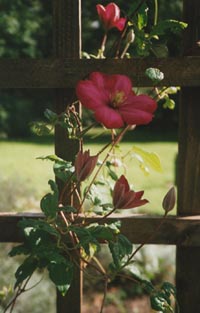
A dry and sunny day on the 19th so opportunity was taken to do a few more jobs around the garden. On the vegetable plot the runner beans and supporting poles were cleared away. The leeks are doing much better this year and we have already taken a few for the kitchen. We are still taking leaves from the sea kale beet and will hopefully do so through most of the winter. The purple sprouting broccoli has also grown well, but several caterpillars were spotted on the leaves and were removed. We still have some pink fir apple potatoes in the ground. These should have been lifted but the weather has just been too wet. The soil is completely saturated and it is very heavy work to dig them out at the moment. We are dig up what we require for a few days; the tubers were quite sound. We were hoping to rotate the cleared plot with the MANTIS, but it seems that this will now not be possible again this year. It will have to be left until the drier weather in the spring. In the greenhouse the tomato plants were finally removed. 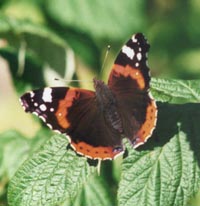 Any remaining tomatoes were picked and put into trays to finish ripening. They do quite well like this; at this stage it is better to do this as the plants/leaves become diseased and it is better to consign them to the compost heap. The growbags, in which the plants were grown this year, were put on the vegetable plot and will be incorporated in the soil when conditions allow. Space is now available to bring in the pots of chrysanthemums whose buds are just about to break, so it is just in time. During the afternoon we spotted several butterflies in the garden including a comma that spent some time feeding on the Polygonium vaccinifolium that is still flowering well. I was unable to get a photograph of this but managed to catch a red admiral on the late raspberries. While the crop of these raspberries has not been heavy they have proved to be a pleasant addition to the menu, for the butterflies and us. We are no longer troubled with wasps; the wet weather seems to have finished off the drones that die off anyway this time of year. The queens will be around still and will be seeking places to over-winter. The dry log pile and garden shed is a favourite hiding place for both wasps and butterflies. Also looking for winter quarters are the mice. They will get into the greenhouse, if they can, and set up in empty pots or under seed trays. The hedgehogs too will be seeking a warm and dry place under twigs and leaves. There are plenty of places around the garden and wood so we have no need to provide any special accommodation for them. All the bird nest boxes have been visited and the old nests cleaned out. Interest is being shown in the boxes again by blue tits; it is likely that they will use them as a dry roosting place during the winter months and being 'in possession' in the spring may go on to raise next year's brood there as well.
Any remaining tomatoes were picked and put into trays to finish ripening. They do quite well like this; at this stage it is better to do this as the plants/leaves become diseased and it is better to consign them to the compost heap. The growbags, in which the plants were grown this year, were put on the vegetable plot and will be incorporated in the soil when conditions allow. Space is now available to bring in the pots of chrysanthemums whose buds are just about to break, so it is just in time. During the afternoon we spotted several butterflies in the garden including a comma that spent some time feeding on the Polygonium vaccinifolium that is still flowering well. I was unable to get a photograph of this but managed to catch a red admiral on the late raspberries. While the crop of these raspberries has not been heavy they have proved to be a pleasant addition to the menu, for the butterflies and us. We are no longer troubled with wasps; the wet weather seems to have finished off the drones that die off anyway this time of year. The queens will be around still and will be seeking places to over-winter. The dry log pile and garden shed is a favourite hiding place for both wasps and butterflies. Also looking for winter quarters are the mice. They will get into the greenhouse, if they can, and set up in empty pots or under seed trays. The hedgehogs too will be seeking a warm and dry place under twigs and leaves. There are plenty of places around the garden and wood so we have no need to provide any special accommodation for them. All the bird nest boxes have been visited and the old nests cleaned out. Interest is being shown in the boxes again by blue tits; it is likely that they will use them as a dry roosting place during the winter months and being 'in possession' in the spring may go on to raise next year's brood there as well.
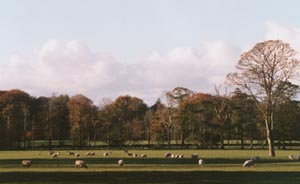
On the 20th we noticed that sheep were back in the 'old cricket field' opposite the house. The rams are in with them and they have been busy as most of the ewes are well marked with coloured marker paint! The cattle will have moved on, or been confined to yards and sheds where they will eat the silage fodder produced during the summer. The ground at this time of year is just too wet and soft to support the weight of cattle. Sheep are able to graze well enough, keeping warm under their waterproof coats, and will remain in the field until the time for lambing that can be as soon as December or January in these parts. 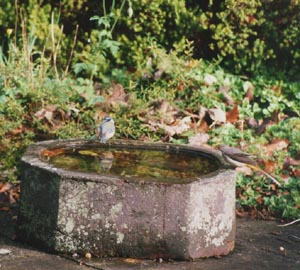
The hedges along the roadsides have been trimmed back and all look very neat and tidy. I always think it is a pity, however, that many of the berries that would be food for birds has been removed. Not all the rose hips and hawthorn berries are removed, and there are the holly berries on the taller holly trees that are not cut back. We have been pleased to see a grey wagtail visiting the garden again over the last 2 weeks. These are regular visitors about this time of year but they usually do not stay for long. This one seemed to enjoy the water we have on the terrace.
It has been one of the wettest Octobers on record. The ground has been saturated with water all month and any rain has simply run-off or gathered in pools. The field in front of the house has been partially flooded on several occasions. On the 29th it turned colder and there was sleet in the evening. The next day snow could be seen lying on the Snowdonia Mountains.
Document dated: 2 November 2000. This page is part of the site maintained at http://www.llansadwrn-wx.co.uk
Copyright ©: 2000 Donald and Patricia Perkins